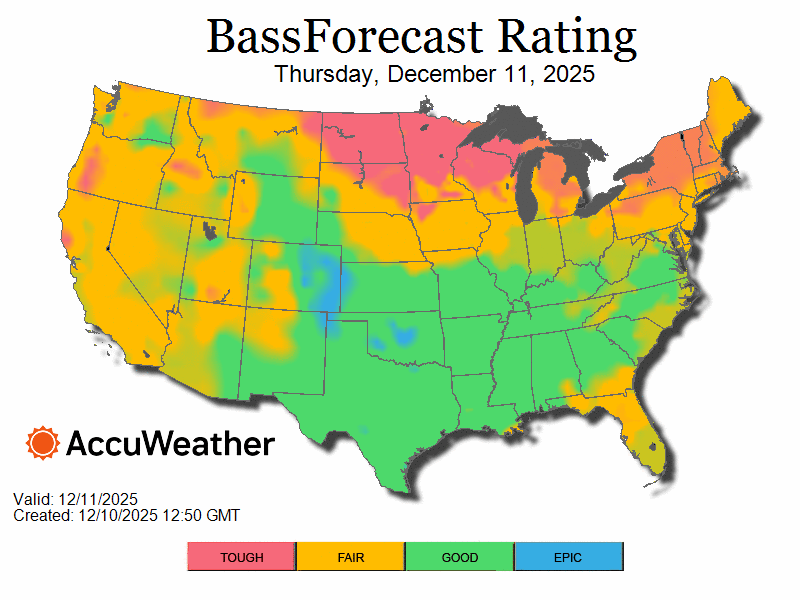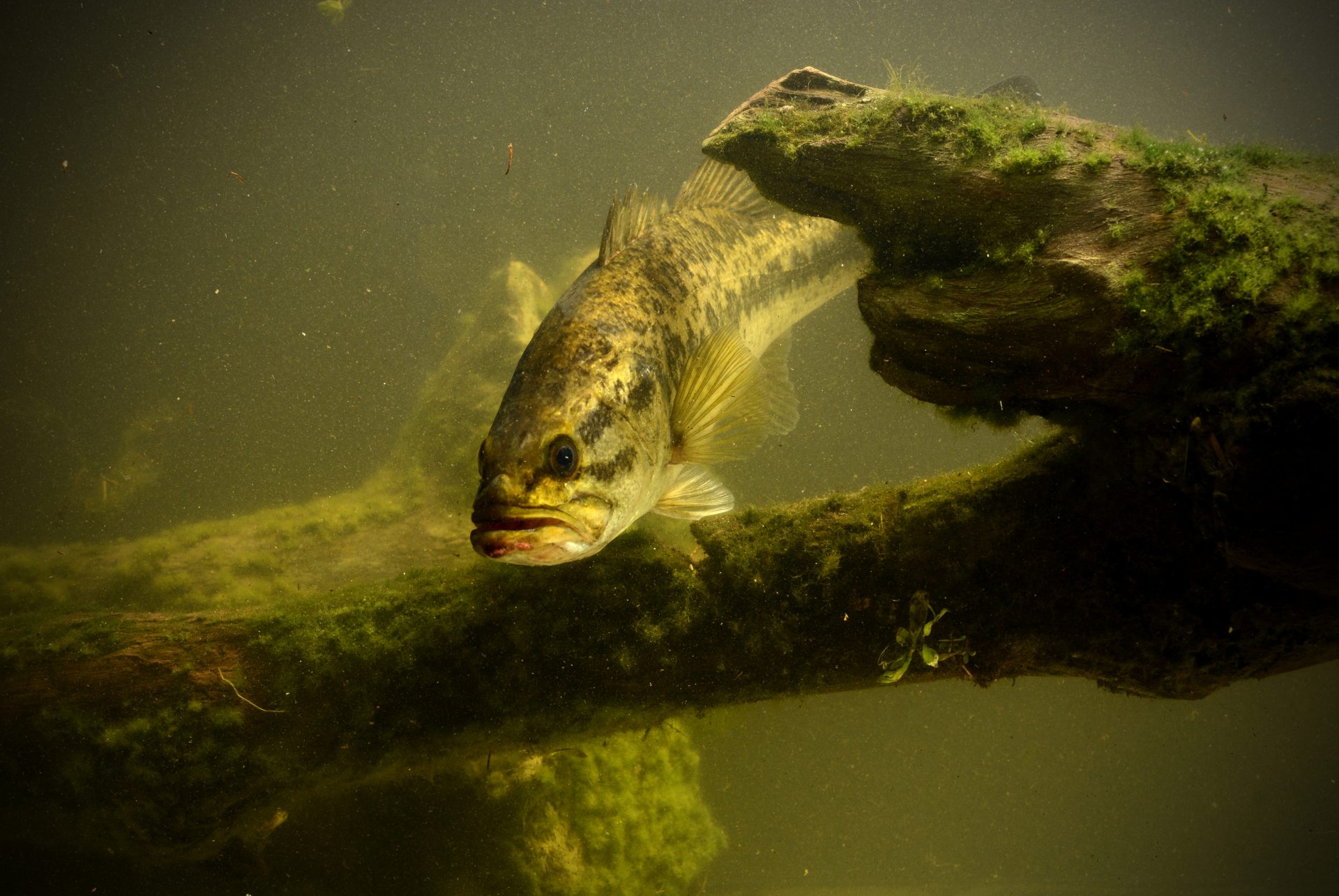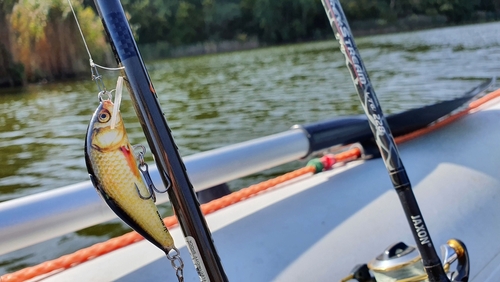The Life Cycle of Bass: An In-Depth Look into Bass Biology
Share this article with every angler you know!
Most experienced anglers know the basics of a bass’s life cycle. They spawn, grow into the small guys that haphazardly chomp on every lure you toss out, and eventually, grow into the massive fighters that everyone loves to get on the end of their line.
However, it’s a little more complex than that. The life of a bass gets fairly complicated when you dig into the details, and from our experience, a lot of anglers don’t understand the extent of that.
We're not going to try to turn you into a marine biologist or anything like that, but the various parts of a bass's lifespan greatly impact your fishing experience in ways you might not even know about. So, we've created this detailed primer to give you a more comprehensive understanding of bass behaviors, biological details, and more.
We’re going to approach this like the circle of life. We’ll start at the birth of a freshly spawned bass and move along all the way until that bass lays its own eggs.
Let’s get started.
Newsletter Signup
1: The Spawn
First, bass lay eggs in clusters in "beds". If you've been fishing for a while, you've probably fished the beds and know what they look like more or less. For everyone else, we'll go into how these beds are made later on.
The imaginary bass we’re following for this guide will stay in its egg for roughly a week. The gestation period is quick, and throughout it, the bass that laid the eggs will hover over the bed to protect against predators during this period when the bass are extremely fragile. It’s a different way to see the apex predator of most North American ponds and lakes, isn’t it?
These eggs look just like the caviar you get in a fine-dining restaurant, and they're laid between February and June in the majority of the country.
The exact time of the spawn will vary dramatically. The water needs to exceed 60 degrees, and it needs to hold that temperature consistently. Bass will typically move to warmer parts of the water once that temperature hits, and they’ll stay there until it’s consistent before laying their eggs.
To find out when bass spawn exactly, it’s best to start watching the water temperature around mid-February. After a few days of 60+ degree weather, it’s a good idea to get on the water.
2: The Hatch
This is also part of the spawn, but it’s a big enough moment to warrant its own section. Around the 5-7 day mark, those little caviar-like eggs hatch. However, bass don’t just come out ready to terrorize all the baitfish around them. They start off as larvae.
These look a lot like tadpoles. They’re essentially a fat body with a weird tail coming out of it. At this stage in the fish’s life, they’re not exactly apex predators, but they do start to develop the skills that will eventually make them the best fish you’ll ever fight. They roam around their spawning beds eating water fleas, and after about a week or so, they move on to insect larvae.
This phase lasts up to 4 weeks before the bass takes the form of what you’re used to seeing. However, they’ll still be so small that you’re unlikely to catch it, and even if you did, it would barely resemble a largemouth bass anatomy.
3: Young of the Year
Now, let's pretend a full year has passed. Our little egg is finally what you expect. You can distinctly tell that the bass is a largemouth because it has its jaw fully developed, its lateral line shows, and when you lip it, its mouth opens like a bucket.
At this point, the bass is still very small. It's no larger than your average bluegill. It also hasn't developed its trademark coloring. This is due to the age of the fish and the water conditions. The fish just finished its first winter, and all bass tend to lighten in color in the winter. So, this bass will likely appear whitish with tinges of light green throughout its upper half.
This is called the “Youth of the Year” phase. At 1-year old, the bass is now eating worms, small crustaceans, and tiny baitfish such as minnows. Throughout the year, it will grow considerably, but it won’t get much larger than a bluegill throughout this stage.
Targeting the youth of the year isn’t really optimal. You don’t want to intentionally hook into these guys and risk damaging them. It will occasionally happen, though. Especially if you’re targeting something else such as bluegill. They won’t put up much of a fight against the average bass rig, either.
Remember, this is the next generation of largemouth in your local watering hole. So, try to take it easy on them.
4: Juveniles
This is where real bass fishing starts. You can technically catch “young of the year” fish, but this is when the bass is developed enough to have all its features, puts up a great fight, and is a lot more likely to end up on your hook. The only visual differences are its skinnier girth and lighter coloring.
The juvenile phase lasts until the bass is 4 years of age, and the fish will pack on the pounds just like a human teenager raiding the pantry every day. They're growing quickly, and they will eat basically the entirety of a grown bass's diet without problems.
Usually, when you're catching bass in the 2 to 4-pound range, they're juveniles. Beyond that, you're likely dealing with a mature largemouth.
The only real difference beyond size is that juveniles are still smaller than the average mature bass. As such, they eat practically everything a mature bass does, but their smaller stature means they eat smaller versions of everything.
It’s not abnormal for a fully matured bass to swallow large bluegill whole, but a juvenile might be stuck eating juvenile bluegill, smaller frogs, etc. They’re still apex predators that can handle practically anything in a North American lake, though. Baitfish certainly don’t scoff when they swim by, and they tend to be more vicious.
Again, they’re a lot like human teenagers at this point. Hungry, angry, and ready for a challenge.
This is when the bass develops all the habits that mature bass follow throughout their lives. Since the next phase is so long, we’ll discuss that in the next section.
5: The Daily Life of a Mature Largemouth Bass
At the end of the 4-year mark, the bass is a fully grown largemouth. This phase also lasts a lot longer than you might think. Assuming anglers practice catch-and-release with proper release and care methods, and nothing gets ahold of the fish in the wild, the largemouth bass can live up to 16 years of age with ease.
The bass doesn’t stop growing throughout this period, either. They’re fully developed, but they’ll keep growing in length, girth, and weight until the day they die. That’s why world records are still able to be broken. There’s no cap to the size they can reach other than their lifespan.
Since this period in a bass’s life lasts for so long, we’ll use this opportunity to highlight the different behaviors they have throughout each year.
Spring:
Here we are at the full circle mark. Once a bass matures and reaches spawning age, each spring is going to be dedicated pretty much solely to the spawn.
Between February and June, depending on where the bass is, the bass is going to sense the water temperature rising, and it’s going to go on a feeding frenzy.
That’s to prepare for what’s to come. This can be a good time to catch big bass if you get on the water while it’s still too cold for the spawn to start, but close enough that the fish are preparing.
However, once the water consistently hits 60 degrees, all bets are off.
The bass are going to migrate to warmer parts of the lake. The males kick into apex predator mode, and they essentially clear the area of anything that resembles a threat. They also clear away debris in a small circle to make a “bed” for eggs to be laid in.
We’re pretending that the bass we’re following is a female. So, during this phase, she’s eating and getting ready to use that bed to lay her eggs. The actual egg-laying process is quick, and there are a lot more eggs than you might think. Our subject will lay between 4000 and 80,000 eggs per pound of body weight. The older the bass is, the more eggs it will lay at once.
Now, don’t get too excited. Your local lake won’t suddenly be full of millions of bass by the time every female hatches her eggs. Many of the eggs will be snatched up by crawfish and other predators that the adults miss, some won’t hatch, and many will never get past the larvae phase.
Still, the population generally restocks itself to a sustainable number as long as the natural ecosystem of the lake is balanced.
This is the perfect time to get your rod in the water, though. The big adults will hover over their beds to protect their eggs aggressively. If you bounce a jig or similar rig over a bed, you can bet you’ll get a good fight quickly.
Summer:
This behavioral phase actually starts shortly after the week-long spawning phase. So, much of spring is the same as this summer phase.
Bass are not social creatures. Even if they're within close proximity to one another, they more or less do not care that other basses exist.
So, you’ll likely find them spread out and doing their own thing in isolation throughout the summer.
They’ll feed on baitfish, topwater prey such as frogs and dragonflies, and occasionally, take out some of the young bass that just spawned.
Depending on the temperature of any given day, the bass might be closer to the surface taking in the sun and going on a feeding frenzy, or they might be suspended lower in the water to cool down; at which point, they won't be as active.
Fall:
Fall bass fishing isn’t too different than spring and summer. The main difference is what the bass will be looking for. Predominantly, their diet will be focused on larger baitfish, and of course, the crawfish that are just now getting ready to molt. Crawfish lures are sure to get you plenty of bass during this phase
The bass will eat voraciously during this period whenever it can, too. Food will be more scarce during the upcoming winter, and they’ll pack on as much weight as possible the closer it gets to the cold season.
Winter:
Finally, the winter phase is when fishing slows down. Not only do most weekend warriors put their rods up for the year, but the bass are lethargic and a lot more difficult to trick.
During this phase, the bass will typically transition between shallow water during sunny parts of the day and deeper water when that’s not an option to take advantage of heat pockets. They aren’t overly active, and you’ll have to change your approach entirely. Mostly, you’ll have to slow down and focus on presentations that give them time to react while enticing them to waste precious energy for a potential meal.
However, this is the best time to catch larger bass. They need the food, and they’ve had all year to grow a bit more.
The End of the Life Cycle
Finally, we’re at the end of the life cycle. After 16 years, and 10-14 spawns, the bass will die.
Most bass don’t make it to this phase. There is a 16.2% chance that catch-and-release methods will, in fact, kill the fish regardless. The trauma can be too much, and debilitating injuries can cause them to die early. You can mitigate this chance by taking time to help the fish recover instead of just chucking it back in the water, using gear and methods that minimize the risk of injury, and generally being a good angler. You also have to account for anglers who don’t participate in CPR methods and the fact that large birds and other animals frequently take bass as juveniles.
If the bass does die naturally or is about to, you’ll find it floating before it’s consumed by other fish or animals in the lake. This is what happened to Dottie. The 21-pound world-record largemouth. In an attempt to catch her a second time, Mac Weakley and his team found her expired.
Now that you understand the full life cycle of a bass, it’s time to get out on the water and engage with them directly. With this info, you can make better fishing decisions, know when to hit the water, and practice safer methods that protect our bass population for generations to come.
For more help, download the Bass Forecast fishing app today.









.png)
.png)